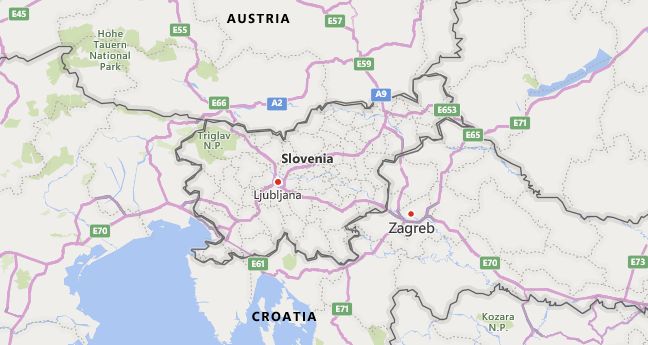There are 4 high school codes in Slovenia today, according to the ACT. The full list is shown below by city, with name of each high school and the city where the school is located (based on the ACT official site). You can search a school code by pressing “Ctrl” + “F” and then type school name or 6-digit school code.
Map of Slovenia
High School Codes by City
- High School Code
- 790042
- High School Code
- 790040
- High School Code
- 790041
- High School Code
- 790043
The above lists CEEB codes (College Entrance Examination Board) for all accredited Slovenia high schools. Please be informed that the list of high school codes in Slovenia may change throughout the year. If you can’t find codes for the high schools of your interest, please write to us or come back at a later time. We will update our database soon after a new high school code is added to the country of Slovenia.
Country Abbreviations
SVN is the three-letter country code of Slovenia, and SI is the two-letter country code of Slovenia. The two-letter suffix is used in top-level domains on the Internet as .si.
Business
Slovenia was the economically most powerful part of the republic in the former Yugoslavia. Slovenia was also affected by the increasingly critical development of Yugoslavia. The market economy transformation initially accelerated the negative economic development, but in 1992 economic stabilization began with high growth rates in the period that followed. Hyperinflation (rate of inflation of the Yugoslav dinar in 1989: 2,763%) was among other things. through the establishment of an independent central bank and the introduction of the new currency tolar (fully convertible from 1995). The gross domestic product (GDP) has achieved consistently high annual growth rates since 1996 (2007: 6.9%, 2008: 3.7%). In the course of the economic crisis in 2009, the country suffered a severe setback; GDP fell by 8.1%. 2010 and 2011 with 0.8 and 2, 4%, a slight upswing is recorded again (2016: 3.1%). In particular, exports, the increase in private consumption and the restructuring of the banking sector have contributed to economic growth in recent years. That Gross national income (GNI) reached US $ 22,000 per resident (2017), inflation was -0.1% and the unemployment rate was 8.7%. The foreign debt in 2017 amounted to € 46.3 billion; the budget deficit was 2.3% of GDP in 2016. Important measures in preparation for EU accession were above all the liberalization of the economy and privatization of the formerly state-owned companies. The Association Agreement with the EU came into force in February 1999, Slovenia has been a member of the EU since May 1, 2004, and a member of the Eurozone since January 1, 2007.
Foreign trade: The foreign trade balance has been negative since independence in 1991, but since 2012 more goods have been exported than imported (2016 import value: US $ 30.5 billion; export value: US $ 32.9 billion). Important export goods are motor vehicles and motor vehicle parts, chemical products and pharmaceuticals, machinery, electrical engineering, metal goods, food and furniture. The main trading partners are Germany, Italy, Austria and Croatia.
Agriculture
In agriculture (2016) around 4% of all employed persons generate 2.3% of GDP. With 477,000 hectares, the usable agricultural area comprises almost a quarter of the total area of the country. Because of the altitude and rich rainfall, around 58% of it consists of meadows and pastures, which are mainly used for cattle and pig breeding. The horse breeding in Lipica (Lipizzaner) is famous. Mainly maize, wheat, potatoes, sugar beet and in the south also hops are grown on the arable land (36% of the arable land). Fruit growing (especially apples) and viticulture (coastal hinterland around Vipava, Haloze south of Ptuj, Podravje around Ormož and Ljutomer in the northeast) are also important.
Forestry: Slovenia is approximately 62% forested. In addition to logging (2013: 3.4 million m 3), hunting, especially for roe deer, deer, wild boar and chamois, is of economic importance.
Fisheries: Fisheries only play an economic role in the area of the narrow Slovenian coastline.
Natural resources
With the exception of coal production (2016: 3.35 million t of lignite), especially in Velenje and Zasavje, mining is of minor importance. Otherwise, mainly building materials (sand, gravel, crushed stone, natural stones) are mined.
Energy industry
Energy generation is based on lignite and hydropower plants (on the Drava, Save and Isonzo) and a nuclear power plant (gross output 730 MW), which is located near Krško on the Save and is operated in equal parts by Slovenia and Croatia. Slovenia covers 36% of its energy needs from nuclear power, 33% from thermal power and around 25% from hydropower. The energy market was partially liberalized in the course of joining the EU.
Industry
In the industrial sector (including mining, energy and construction) (2016) around 32% of the workforce generated 32.4% of GDP. The structure of the manufacturing industry is diverse. The most important branches of industry are metal producing and metal processing industry (steel industry, aluminum works), textile and leather industry (especially in Maribor and Kranj), chemical and pharmaceutical industry, machine and vehicle construction, wood, paper and furniture industry, food and electrical and electronic industry. The main industrial centers are Ljubljana and Maribor.

